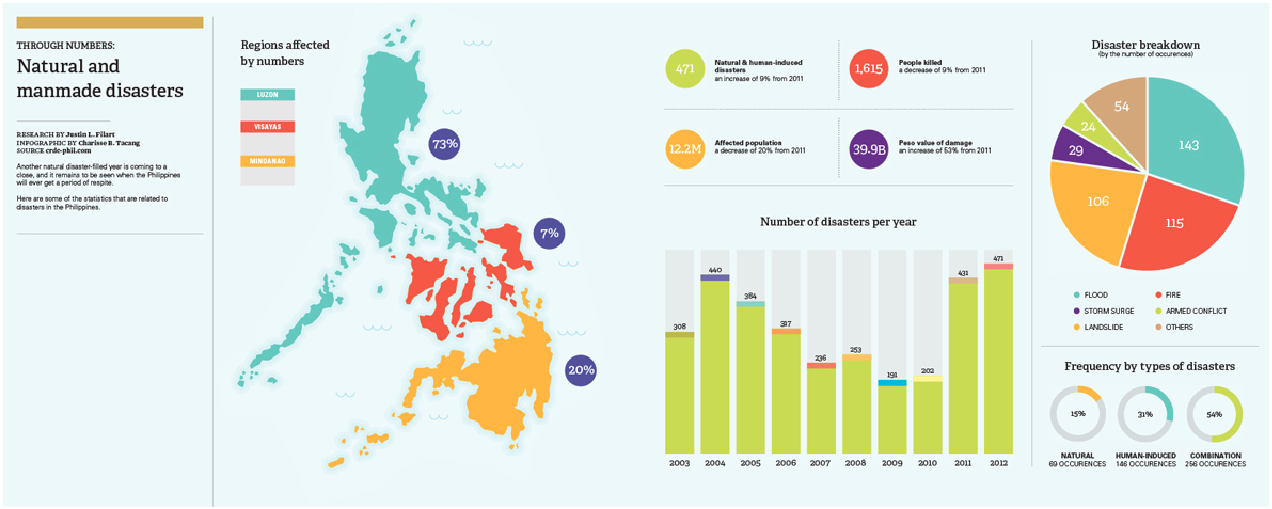Infographic by Charisse B. Tacang
Is government aid under a ‘state of calamity’?
Ateneo dormer Nina Nalda lost contact with her family on November 8, the day Super Typhoon Yolanda made landfall in Eastern Visayas. In a Facebook post dated November 11, she finally announced: “Alive. They are all alive. All 44 of them.”
But the succeeding paragraphs were not as jubilant: She talked about a lack of order, fallen buildings and health risks. “Tacloban,” she said, “has ceased to be the ideal place to start and raise a family.”
It wasn’t until almost a week later, on November 13, that her family received relief goods. They procured some rice and sardines, but they were unable to receive a second round for another four or so days. In the interim, the family survived on rationed food and looting, as did the rest of the barangay.
Nalda believes that the reason for the bottleneck of relief goods lies in bureaucracy. She cites as an example the fact that the Department of Social Welfare and Development (DSWD) would first repack all donations. It might be deemed systematic, but they can’t keep people waiting. She says, “Give what is due to Tacloban.”
Meeting marathons
The slow response from national government after Typhoon Yolanda not only garnered complaints from survivors but criticism from volunteers on the ground as well. “Puro meeting sa taas, wala namang nangyari sa baba (The are many meetings among higher-ups, but nothing happened on the ground). It took them five days to mobilize,” a Rappler article quoted Dr. Nats Rempillo, one of the delegates sent by the Albay provincial government to help in Tacloban.
There was even confusion as to who should take charge of the situation. “There is an existing law, RA 10121, the Disaster Risk Reduction Management Act, that set up the National Disaster Risk Reduction and Management Council (NDRRMC) with the Secretary of National Defense [in] charge since he can then mobilize the Armed Forces to act quickly,” said Dr. Victor Venida of the Ateneo Economics Department. He added that they are the state’s best-trained corps for emergencies.
The NDRRMC chairperson is Defense Secretary Voltaire Gazmin, while the vice-chairperson for disaster response is DSWD Secretary Dinky Soliman. However, a field reporter told Rappler, “Dinky was reporting to [Interior Secretary Mar] Roxas. All the military officials in Tacloban were reporting to him.”
When international media criticized the government for its perceived failures, officials countered that the situation was not an ordinary disaster, as Typhoon Yolanda is thought to be one to the strongest in history. “Nothing is fast enough in a situation like this,” Roxas told CNN.
Caught unprepared
There are competing narratives about the disaster response of Aquino’s government to Typhoon Yolanda: The government story on the one hand, and anecdotes from survivors and media reporters on the other.
There is, however, one glaring fact that the administration cannot deny: In 2011, Aquino’s first year in office, he vetoed a P5-billion allocation of the Calamity Fund for disaster preparedness, a move that has come back to haunt him.
“I caution the inclusion of pre-disaster activities such as preparation of relocation sites/facilities and training of personnel engaged in direct disaster in the use of the Calamity Fund,” the president explained then.
He said that the money should instead be used for “actual calamities” and he wished to prevent the Calamity Fund’s “full utilization for pre-disaster activities” since disaster preparedness had been “subsumed” by other implementing agencies.
RA 10121 mandates a constant revolving fund of P1 billion for the Office of Civil Defense (OCD), the lead agency charged with spearheading the disaster risk management policies of the government. It also handles the NDRRMC.
Yet a glance at the National Expenditure Program of the Department of Budget and Management shows that the funding for OCD in the first half of Aquino’s term was highly variable: The OCD budget allocations were P85 million in 2010, P90 million in 2011, P1.22 billion in 2012 and P657 million in 2013.
The need for alert LGUs
Ultimately, local government units (LGUs) have a pivotal role in disaster preparedness and response. After all, LGUs are expected by law to be the “first responders.”
The provincial government of Albay, for example, earned the “zero casualty” record on natural disasters since Joey Salceda became governor last 2007. This was despite more than 12 hectares of the province being considered a flood hazard, its coastline being vulnerable to tsunamis and storm surges and 73% of its land area being prone to soil erosion and landslides, according to a Human Development Network report.
Disaster preparedness for Albay includes engineering interventions such as dikes, sea walls and drainage systems, community-based warning systems, strict protection of the environment and agriculture crops that improve vegetative cover.
When a typhoon hits, government response includes well-coordinated evacuations. Salceda even gave a tip in an ABS-CBN interview: Offer people sacks of rice in exchange for them leaving their homes. “That’s an incentive. They will go there because the rice is there; you don’t have to force them.”
Other localities have also been commended for their disaster preparedness. “LGUs like Marikina [which were] severely damaged by Ondoy, have a working system in cases of floods that have worked quite well thus far in the calamities of the past three years,” Venida said. In the case of Typhoon Yolanda, Venida also cited the LGUs of Camote Island and Sagay for the immediate evacuation of their residents after the forecasts were announced.
Prepare for the worst, hope for the best
In response to criticism regarding the national government’s seemingly poor preparation and slow response, the President noted that some areas were badly affected because of LGU incompetence. Dr. Remmon Barbaza of the Ateneo Philosophy Department, however, said that blaming them should not have been the response. “It would be simplistic, I think, to do so. And more important, it would not be constructive to do so,” he said.
In a report published by Rappler, Tacloban Mayor Alfred Romualdez reacted to the national government’s finger pointing, retorting, “Will we insult the dead and say they died because they were unprepared?”
Barbaza hopes that an assessment of government response will be made after the relief operations. “We must identify and specify where exactly there was negligence or incompetence, if not outright violation of human rights or dignity. The question is not so much the number of deaths, but rather how many of those deaths were avoidable,” he explained. “Insofar as they are avoidable, then someone has to be made accountable for it.”
More allocation for disaster preparedness is also needed. “Using government budget to purchase more aircrafts or boats that could be used to transfer goods or putting up evacuation centers similar to the city of Manila would just be some things that would make sense for the government to do so that we wouldn’t be caught off-guard next time,” suggested Joseph Barcelon, head of the Ateneo Disaster Response and Management Team student arm.
Disaster risk management also becomes more relevant if one sees the grave impact of calamities on the poor. “The growth in their standard of living therefore can be often be pushed back by these events which makes their upward mobility even more difficult,” Venida said. He lists the “social infrastructure” that the low-income groups depend on: small businesses, public schools, public healthcare providers and public housing.
In the end, disaster preparedness is also an issue of social justice. As Barbaza concluded, it is about “justice to those who still stand unnecessarily vulnerable to future calamities.”
Disaster digest 2013
Sources: ndrrmc.gov.ph, newsinfo.inquirer.net, interaksyon.com, anc.yahoo.com, radioaustralia.net.au, sunstar.com.ph
The location of the Philippines has always left it vulnerable to natural calamities and disasters. Here are some of the events of 2013 that harmed different parts of the country.
Davao faces Crising
On February 19, Tropical Depression Crising battered Southern Philippines, causing heavy rains and flooding in the region and leaving four casualties, two missing and P11.2 million in agricultural damages.
Cotabato cower
Last June 1, a 5.7 magnitude earthquake with 190 aftershocks rattled Carmen, Northern Cotobato. This tremor left the affected area with 141 damaged houses, four damaged schools, three damaged churches and seven injuries. There were no casualties.
Talisay meets tornado
A tornado visited Talisay City, Southern Cebu last June 18. Reaching speeds of up to 200 km per hour, the tornado left Talisay with three injuries, 33 destroyed houses, and three villages without power.
Mishap in Mindanao
Last July 31, Tropical Storm Jolina made landfall and submerged 21 towns in North, affecting 30,000 people.
Marring the greater Luzon area
Metro Manila and provinces in Luzon bore witness to the wrath of Severe Tropical Storm Maring on August 18. The rainfall caused the Marikina River to reach 19 meters in depth. This resulted in five areas declaring a state of calamity and eight casualties.
Santi reaches Aurora
Power outages marked the arrival of Category 3 Typhoon Santi on October 11. The typhoon caused heavy damage in Northeastern Philippines, resulting in five deaths affecting two million people.
Quake hits Cebu and Bohol
A 7.2 magnitude earthquake surprised areas in Visayas on October 15, wreaking havoc and devastation throughout several highly populated areas. The earthquake severely affected Cebu City and Bohol, leaving the areas with 215 casualties, 760 injuries, 664,389 families affected and P 2.20 billion in estimated damages.
New heights of devastation
Typhoon Haiyan (Local name: Yolanda)
Thought to be one of the strongest typhoons to ever make landfall, Category 5 Super Typhoon Yolanda arrived on November 8, causing devastation throughout the Visayas region. As of press time, recovery operations are still ongoing. According to the latest releases by the government, the death toll has reached 5,600, with 1,200 still missing and at least 10 million affected.




